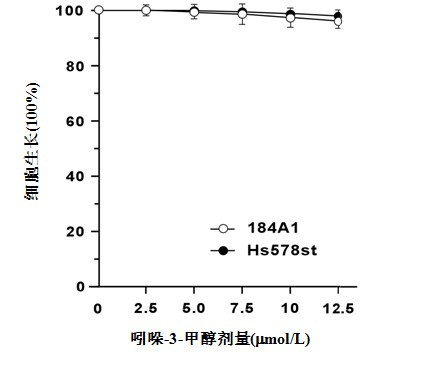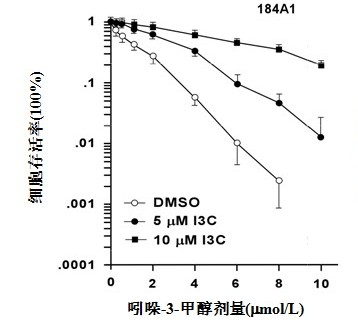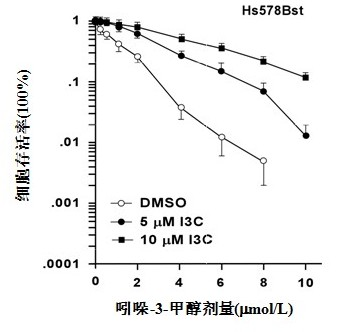Application of indole-3-methanol serving as BRCA1 (breast cancer 1) inducer to preparation of radiation injury protection medicament
A radiation damage and indole technology, which is applied in the field of radiation damage protection drugs, can solve the problem of no radiation damage protection effect of indole-3-carbinol, and achieve the effect of protecting radiation damage.
- Summary
- Abstract
- Description
- Claims
- Application Information
AI Technical Summary
Problems solved by technology
Method used
Image
Examples
Embodiment 1
[0023] (1) Cell culture: Culture the cells in D-MEM medium containing 10% calf serum, glutamine, 1 million U / L penicillin and 100 μg / ml streptomycin. Cells were placed in 5% CO 2 , 37 o C culture in the incubator, subculture once every 2-3 days, and take the cells in the logarithmic growth phase for the experiment.
[0024] (2) 184A1 and Hs578Bst cells (6×10 4 / mL) were inoculated into a 96-well plate, and after culturing for 24 hours, different concentrations of indole-3-carbinol were added at a concentration of 0-10 μmol / L, and 6 parallel wells were set for each concentration. After continuing to culture for 24 hours, add 20 μl of MTT (20 μl / ml) to the cell culture medium and continue to culture for 4 hours. Aspirate the culture medium, add 150 μl DMSO to each well, and shake gently on a shaker for 10 minutes. Finally, the optical density was detected by a microplate reader (A570 nm / A630 nm absorbance value), and the cell survival rate was calculated by the method of cel...
Embodiment 2
[0026] (1) cell culture is the same as embodiment one;
[0027] (2) 184A1 and Hs578Bst cells (6×10 4 / mL) were inoculated into 60 mm culture dishes, and the cells were treated with different concentrations (0, 5, 10 μmol / L) of indole-3-carbinol for 24 hours, and then given different doses (0, 2, 4, 6, 8, 10 Gy) of γ-ray irradiation (irradiation conditions: a medical 60 Co γ-ray irradiation source with a dose rate of 0.9 Gy / min). Cells after exposure (1 x 10 4) were inoculated into 60 mm culture dishes, and then cultured continuously for 3 weeks, fixed with methanol, stained with Giemsa application solution for 30 minutes, washed with running water, and counted the number of clones with the number of cells ≥ 50. The colony formation rate and survival fraction were calculated by clone formation rate PE = (clones number in control group / cell number in experimental group) x 100% and survival fraction = clone number / (cell number in experimental group × PE). The result is as f...
Embodiment 3
[0030] SD rats (6 weeks old, about 170g) were raised in a clean animal room with a temperature of 22+ / -2 and a humidity of 60%, and they could freely obtain water and food. The SD rats were randomly divided into two groups : control group and treatment group, 10 in each group; see Figure 4 Shown, wherein, give control group SD rat whole body 13Gy lethal dose irradiation, then observe the death situation of animal continuously for 30 days, the result finds that to the 13th day, control group SD rat all dies; , 50 mg / kg indole-3-carbinol was injected intraperitoneally 24 hours before irradiation, and then SD rats were irradiated with a lethal dose of 13Gy, and then intraperitoneally injected indole-3-carbinol for 7 consecutive days after irradiation, with a total dose of 350 mg / kg, and then observe the death situation of the animals for 30 consecutive days, and it was found that: the animals that received indole-3-carbinol also had 50% of the animals survived after 30 days, an...
PUM
 Login to View More
Login to View More Abstract
Description
Claims
Application Information
 Login to View More
Login to View More - R&D
- Intellectual Property
- Life Sciences
- Materials
- Tech Scout
- Unparalleled Data Quality
- Higher Quality Content
- 60% Fewer Hallucinations
Browse by: Latest US Patents, China's latest patents, Technical Efficacy Thesaurus, Application Domain, Technology Topic, Popular Technical Reports.
© 2025 PatSnap. All rights reserved.Legal|Privacy policy|Modern Slavery Act Transparency Statement|Sitemap|About US| Contact US: help@patsnap.com



